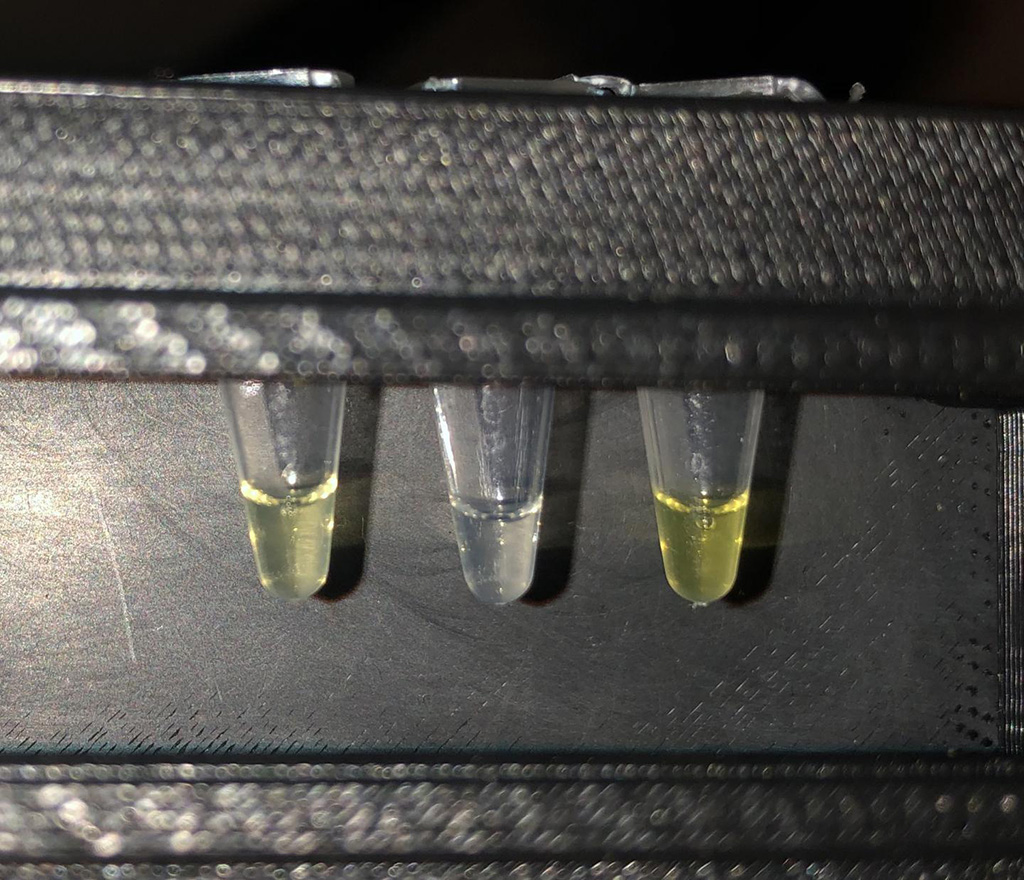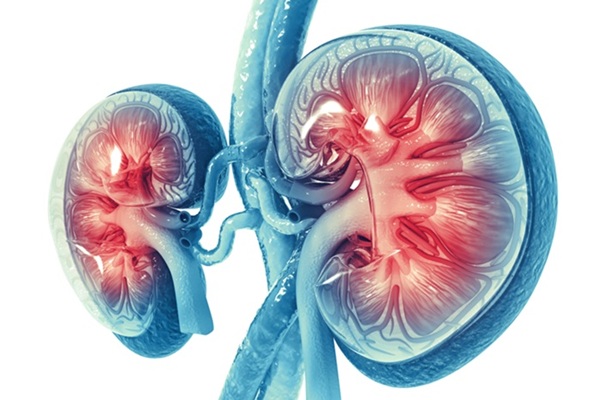Novel Biotech-Based Field or Lab Assay for Detection of Fluoride
|
By LabMedica International staff writers Posted on 26 Dec 2019 |

Image: The test tube on the left shows a real positive result from water sampled in Costa Rica. The middle tube is a negative control. The tube on the right is a positive control (Photo courtesy of Dr. Julius B. Lucks, Northwestern University)
A simple, yet sophisticated biotech-based assay for the detection of fluoride levels was successfully tested in the laboratory and in the field.
Around one-third of the human population drinks water from groundwater resources. Of this, about 10%, approximately three hundred million people, obtain water from groundwater resources that are heavily contaminated with arsenic or fluoride. When consumed in high amounts over long periods of time, fluoride can cause skeletal fluorosis, a painful condition that hardens bones and joints.
Current laboratory methods to measure fluoride levels in groundwater are expensive and time consuming and may not be available in developing countries. Investigators at Northwestern University (Evanston, IL, USA) suggest replacing this methodology with a rapid, easy-to-use, inexpensive biotech-based assay.
This assay comprises a biosensor consisting of a cell-free system containing a DNA template that encodes a fluoride-responsive riboswitch, which regulates genes that produce a fluorescent or colorimetric output. A riboswitch is a regulatory segment of a messenger RNA molecule that binds a small molecule, resulting in a change in production of the proteins encoded by the mRNA. Thus, an mRNA that contains a riboswitch is directly involved in regulating its own activity, in response to the concentrations of its effector molecule. In the current assay system, the presence of fluoride causes the RNA to produce a protein enzyme that makes a yellow pigment that is readily visible to the naked eye.
Senior author Dr. Julius Lucks, associate professor of chemical and biological engineering at Northwestern University, said, "RNA folds into a little pocket and waits for a fluoride ion. The ion can fit perfectly into that pocket. If the ion shows up, then RNA expresses a gene that turns the water yellow. If the ion does not show up, then RNA changes shape and stops the process. It is literally a switch."
Reagents for individualized tests may be lyophilized for long-term storage. Following reconstitution with 20 microliters of liquid sample and incubation at room temperature for two hours, the test could detect fluoride at levels above two parts per million, the [U.S.] Environmental Protection Agency’s most stringent regulatory standard, in both laboratory and field conditions.
The prototype assay was successfully tested in Costa Rica, where the Irazu volcano causes heavy contamination of the groundwater with fluoride.
"In the United States, we hear about fluoride all the time because it is in toothpaste and the municipal water supply," said Dr. Lucks. "It makes calcium fluoride, which is very hard, so it strengthens our tooth enamel. But above a certain level, fluoride also hardens joints. This mostly is not an issue in the United States. But it can be a debilitating problem in other countries if not identified and addressed. Every test on these field samples worked. It is exciting that it works in the lab, but it is much more important to know that it works in the field. We want it to be an easy, practical solution for people who have the greatest need. Our goal is to empower individuals to monitor the presence of fluoride in their own water."
The fluoride detection test was described in the December 13, 2019, online edition of the journal ACS Synthetic Biology.
Related Links:
Northwestern University
Around one-third of the human population drinks water from groundwater resources. Of this, about 10%, approximately three hundred million people, obtain water from groundwater resources that are heavily contaminated with arsenic or fluoride. When consumed in high amounts over long periods of time, fluoride can cause skeletal fluorosis, a painful condition that hardens bones and joints.
Current laboratory methods to measure fluoride levels in groundwater are expensive and time consuming and may not be available in developing countries. Investigators at Northwestern University (Evanston, IL, USA) suggest replacing this methodology with a rapid, easy-to-use, inexpensive biotech-based assay.
This assay comprises a biosensor consisting of a cell-free system containing a DNA template that encodes a fluoride-responsive riboswitch, which regulates genes that produce a fluorescent or colorimetric output. A riboswitch is a regulatory segment of a messenger RNA molecule that binds a small molecule, resulting in a change in production of the proteins encoded by the mRNA. Thus, an mRNA that contains a riboswitch is directly involved in regulating its own activity, in response to the concentrations of its effector molecule. In the current assay system, the presence of fluoride causes the RNA to produce a protein enzyme that makes a yellow pigment that is readily visible to the naked eye.
Senior author Dr. Julius Lucks, associate professor of chemical and biological engineering at Northwestern University, said, "RNA folds into a little pocket and waits for a fluoride ion. The ion can fit perfectly into that pocket. If the ion shows up, then RNA expresses a gene that turns the water yellow. If the ion does not show up, then RNA changes shape and stops the process. It is literally a switch."
Reagents for individualized tests may be lyophilized for long-term storage. Following reconstitution with 20 microliters of liquid sample and incubation at room temperature for two hours, the test could detect fluoride at levels above two parts per million, the [U.S.] Environmental Protection Agency’s most stringent regulatory standard, in both laboratory and field conditions.
The prototype assay was successfully tested in Costa Rica, where the Irazu volcano causes heavy contamination of the groundwater with fluoride.
"In the United States, we hear about fluoride all the time because it is in toothpaste and the municipal water supply," said Dr. Lucks. "It makes calcium fluoride, which is very hard, so it strengthens our tooth enamel. But above a certain level, fluoride also hardens joints. This mostly is not an issue in the United States. But it can be a debilitating problem in other countries if not identified and addressed. Every test on these field samples worked. It is exciting that it works in the lab, but it is much more important to know that it works in the field. We want it to be an easy, practical solution for people who have the greatest need. Our goal is to empower individuals to monitor the presence of fluoride in their own water."
The fluoride detection test was described in the December 13, 2019, online edition of the journal ACS Synthetic Biology.
Related Links:
Northwestern University
Latest Technology News
- Embedded GPU Platform Enables Rapid Blood Profiling for POC Diagnostics
- Viral Biosensor Test Simultaneously Detects Hepatitis and HIV
- Acoustofluidic Device to Transform Point-Of-Care sEV-Based Diagnostics
- AI Algorithm Assesses Progressive Decline in Kidney Function
- Taste-Based Influenza Test Could Replace Nasal Swabs with Chewing Gum
- 3D Micro-Printed Sensors to Advance On-Chip Biosensing for Early Disease Detection
- Hybrid Pipette Combines Manual Control with Fast Electronic Aliquoting
- Coral-Inspired Capsule Samples Hidden Bacteria from Small Intestine
- Rapid Diagnostic Technology Utilizes Breath Samples to Detect Lower Respiratory Tract Infections
Channels
Clinical Chemistry
view channel
VOCs Show Promise for Early Multi-Cancer Detection
Early cancer detection is critical to improving survival rates, but most current screening methods focus on individual cancer types and often involve invasive procedures. This makes it difficult to identify... Read more
Portable Raman Spectroscopy Offers Cost-Effective Kidney Disease Diagnosis at POC
Kidney disease is typically diagnosed through blood or urine tests, often when patients present with symptoms such as blood in urine, shortness of breath, or weight loss. While these tests are common,... Read moreHematology
view channel
Viscoelastic Testing Could Improve Treatment of Maternal Hemorrhage
Postpartum hemorrhage, severe bleeding after childbirth, remains one of the leading causes of maternal mortality worldwide, yet many of these deaths are preventable. Standard care can be hindered by delays... Read more
Pioneering Model Measures Radiation Exposure in Blood for Precise Cancer Treatments
Scientists have long focused on protecting organs near tumors during radiotherapy, but blood — a vital, circulating tissue — has largely been excluded from dose calculations. Each blood cell passing through... Read more
Platelets Could Improve Early and Minimally Invasive Detection of Cancer
Platelets are widely recognized for their role in blood clotting and scab formation, but they also play a crucial role in immune defense by detecting pathogens and recruiting immune cells.... Read more
Portable and Disposable Device Obtains Platelet-Rich Plasma Without Complex Equipment
Platelet-rich plasma (PRP) plays a crucial role in regenerative medicine due to its ability to accelerate healing and repair tissue. However, obtaining PRP traditionally requires expensive centrifugation... Read moreImmunology
view channel
Blood-Based Liquid Biopsy Model Analyzes Immunotherapy Effectiveness
Immunotherapy has revolutionized cancer care by harnessing the immune system to fight tumors, yet predicting who will benefit remains a major challenge. Many patients undergo costly and taxing treatment... Read more
Signature Genes Predict T-Cell Expansion in Cancer Immunotherapy
Modern cancer immunotherapies rely on the ability of CD8⁺ T cells to rapidly multiply within tumors, generating the immune force needed to eliminate cancer cells. However, the biological triggers behind... Read moreMicrobiology
view channel
Fast Noninvasive Bedside Test Uses Sugar Fingerprint to Detect Fungal Infections
Candida bloodstream infections are a growing global health threat, causing an estimated 6 million cases and 3.8 million deaths annually. Hospitals are particularly vulnerable, as weakened patients after... Read more
Rapid Sepsis Diagnostic Device to Enable Personalized Critical Care for ICU Patients
Sepsis is a life-threatening condition that occurs when the body’s response to infection spirals out of control, damaging organs and leading to critical illness. Patients often arrive at intensive care... Read morePathology
view channel
Tears Offer Noninvasive Alternative for Diagnosing Neurodegenerative Diseases
Diagnosing and monitoring eye and neurodegenerative diseases often requires invasive procedures to access ocular fluids. Ocular fluids like aqueous humor and vitreous humor contain valuable molecular information... Read more
AI-Powered Method Combines Blood Data to Accurately Measure Biological Age
Chronological age tells us how many years we’ve lived, but not how quickly our bodies are ageing. Some people stay healthy well into their 80s or 90s, while others experience decline much earlier.... Read moreTechnology
view channel
Embedded GPU Platform Enables Rapid Blood Profiling for POC Diagnostics
Blood tests remain a cornerstone of medical diagnostics, but traditional imaging and analysis methods can be slow, costly, and reliant on dyes or contrast agents. Now, scientists have developed a real-time,... Read more
Viral Biosensor Test Simultaneously Detects Hepatitis and HIV
Globally, over 300 million people live with Hepatitis B and C, and 40 million with HIV, according to WHO estimates. Diagnosing bloodborne viruses such as HIV and Hepatitis B and C remains challenging in... Read moreIndustry
view channel
Advanced Instruments Merged Under Nova Biomedical Name
Advanced Instruments (Norwood, MA, USA) and Nova Biomedical (Waltham, MA, USA) are now officially doing business under a single, unified brand. This transformation is expected to deliver greater value... Read more





















